Alright, listen up.
Building a strong programming portfolio, it ain’t just about throwing code at the wall. It’s about telling a story, a good one.
Think of it, not as a resume dump, but as your personal art show, where your code is the art.
Some study says, and who am I to argue with a study, that 70% of tech guys care more about your portfolio than your resume. That’s your chance, the first one, make it count. Forget quantity, that’s for the birds. It’s quality, that’s what speaks.
A couple of good ones will always beat a pile of half done messes.
It’s about the problems you fixed, the skills you showed, and the tale each project spins. It’s about showing you can do, not just talk.
A weak portfolio, that’s a missed shot, like a handshake with no grip, or a blank canvas with no point. You don’t want that.
A strong one, that’s your digital handshake, the one that gets you through the door, sets you apart.
It needs to be clear, effective, and memorable, not a suggestion, a must. It needs direction, like a good compass. Each project, needs to be sharp, focused.
Show them you can solve hard problems, with the know-how to handle algorithms, and with good code, the kind that works.
User experience, that ain’t just for the pretty front end, it matters in the back too, all of it.
Make sure it looks good, even in the back end, that shows you care.
If you want to go the extra mile, make your own stuff, something that shows off your skills, in a lot of fields, that will make you stand out. Now, you got to know your audience.
Are you trying to impress a startup, a big company, or some guy looking for freelance? You tailor the portfolio to what they want.
Startups, they want speed and versatility, big companies, they want the specialization, and scale.
The freelance guys, they want things that work, and look good, to them.
Open source work shows you can play with others, how you can collaborate.
Before you pick any project, you got to know where you’re going.
Do you want a new job, or some side cash? Or do you want to show off that sweet Javascript you know.
Make sure your goals and the projects match, that will keep you on course.
You need steps, having goals is not enough, you got to know how you get there.
Remember this, choosing the projects is a plan, not luck, they are your chance to brag, not just some practice.
Pick projects that show off your strengths, don’t hide the good stuff.
If you’re a front-end wizard, make it rich, and interactive.
If you’re a back-end beast, build an API, or a database, something that makes you proud.
Match it to your path, don’t build something with no relation to the job you want.
If you want to work in fintech, build a trading bot.
If you want to play with AI, build something with machine learning. Most important, remember balance.
Complexity and completion, a complex, unfinished thing is nothing, small, finished projects are always better than huge, unfinished ones, always. And don’t think too hard.
The best project ideas, they come from daily problems.
What bothers you? What can be improved? Look around, the answers are there.
Sometimes a project won’t work, that’s okay, you don’t have to finish everything.
You got to know when to quit, and focus on what really matters. Now, think of project types that impress.
Web applications, they’re always a hit, show them you can build something that works. Mobile, that shows you know what everyone uses. Back end, it’s the heart of everything.
If you want to stand out, learn machine learning and data science.
Open source, that shows you can work with others, that you are a team player. When you are ready to show it all, make it easy. Easy to see the code, and try the project.
Start with clear descriptions, the goals, the problems, the tech.
Add pictures, not just words, screenshots are always good, and if you got the design chops, show them. Easy access to your code.
You got to have good Readme files, those are the maps to your projects.
Pick the right platform to show off your apps, it matters.
Your work, it isn’t done when the code is, the portfolio needs to be updated, always. Not a one-time thing, but a constant job. Always add new projects, show you’re growing.
Go back to the old ones and make them better, clean up the code. Ask for feedback, don’t be afraid to change. Keep up with the new stuff in the industry.
And make a website, that’s your digital home, shows you are serious.
Get a custom domain, matters more than you think, shows you are professional.
Make sure the site is easy to navigate, simple design helps. Show your skills, clearly, don’t hide your talents.
Add a contact form, that’s an easy way for people to reach out. And if you can, add a blog, it shows your know-how.
When you are done, network, share your portfolio, it’s the only way for people to see your work, what is all of it for if no one sees it? Use LinkedIn and GitHub, that’s your stage.
Join online communities, that’s where you learn, and you can work with others.
Show the portfolio to potential employers, it’s the best proof you got.
And get a mentor, ask for feedback, others can help you grow.
Defining a Strong Programming Portfolio
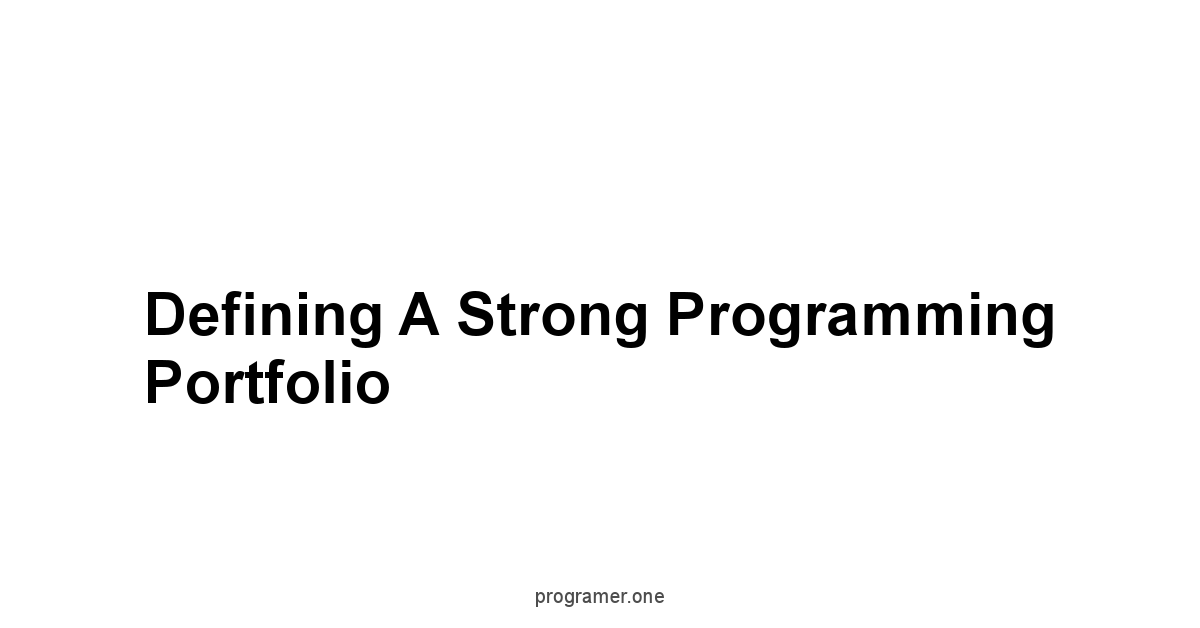
A strong programming portfolio, it’s not just a collection of code. It’s a statement.
It tells a story about what you can do, what problems you solve, and how you approach challenges.
It’s your digital handshake, your first impression in the competitive world of tech.
It needs to be more than just a list, it needs to be a narrative.
Think of it as a carefully curated exhibition, each piece selected to highlight a different facet of your abilities. The goal, to show, not just tell.
A weak portfolio, it’s like a blank canvas, full of potential but lacking direction. It’s a missed opportunity.
A strong portfolio, however, is a powerful tool, it opens doors.
It shows that you are not just someone who knows the theory but someone who can execute, someone who can build.
It makes the difference between getting an interview and getting your resume tossed aside.
You need it to speak clearly, to be effective, and to be memorable.
What Makes a Portfolio Stand Out
A portfolio that stands out isn’t just about having the fanciest projects, it’s about clarity.
It showcases the depth of your skills, not just the breadth. This is about quality, not just quantity.
A couple of well-executed projects trump a dozen half-finished ones.
It’s about the story you tell with each project, the problems you solved and the skills you used.
Every project should demonstrate a specific skill or technique.
Here is what it takes for a portfolio to get noticed, to make an impression.
- Clear Objectives: Each project should have a clear purpose and objective that’s easily understood.
- Problem Solving: Show how you tackled problems, including any challenges you faced.
- Technical Depth: Demonstrate your ability to implement complex techniques and algorithms.
- Code Quality: Clean, well-documented code is a must.
- User Experience: A focus on the end user is important even on the back end.
- Visual Appeal: Good design matters, even in back end projects.
- Unique Projects: If possible, show off projects that are original and that demonstrate your skills in different fields.
Knowing Your Audience
Understanding your audience, it’s crucial before you start building.
You need to know who you are trying to impress with the portfolio.
Are you targeting startups, large tech companies, or freelance clients? Each audience has different expectations.
What a startup looks for might differ wildly from what a corporation expects.
Tailor your portfolio to fit the job and the industry that you are interested in.
Here is a breakdown of different target audiences and what they might be interested in.
| Audience | What They Look For | Project Focus |
|---|---|---|
| Startup | Versatility, rapid problem-solving | Full-stack applications, proof of concept |
| Large Company | Specialization, scalability | Scalable systems, modular code |
| Freelance Client | Practical applications, user focus | End-user projects, specific niche solutions |
| Open Source | Collaboration, code clarity | Community projects, code contributions |
Understanding the needs of your audience will help you choose the right projects for your portfolio and position you perfectly for the type of job you want.
Setting Clear Goals for Your Portfolio
Setting goals, it’s about defining your mission.
What do you want your portfolio to achieve? Are you looking for a job, freelance work, or collaborations? Maybe you want to show your mastery of a specific technology or language.
Having clear goals guides your choices, ensuring your portfolio is a targeted, effective tool. This focus keeps you from being scattered.
Here are some examples of clear goals you might set:
- Job Placement: Aim to get hired by showcasing skills relevant to your target industry.
- Freelance Work: Attract clients with practical, client-focused projects.
- Technology Showcase: Display expertise in a specific technology or language, like Python or JavaScript.
- Personal Branding: Demonstrate your unique approach to problem-solving.
- Community Contribution: Show your active participation in open-source projects.
It is not enough to just have a goal, you must also break the goals down into actionable steps.
Having goals and clear steps helps with motivation and momentum.
Choosing the Right Projects
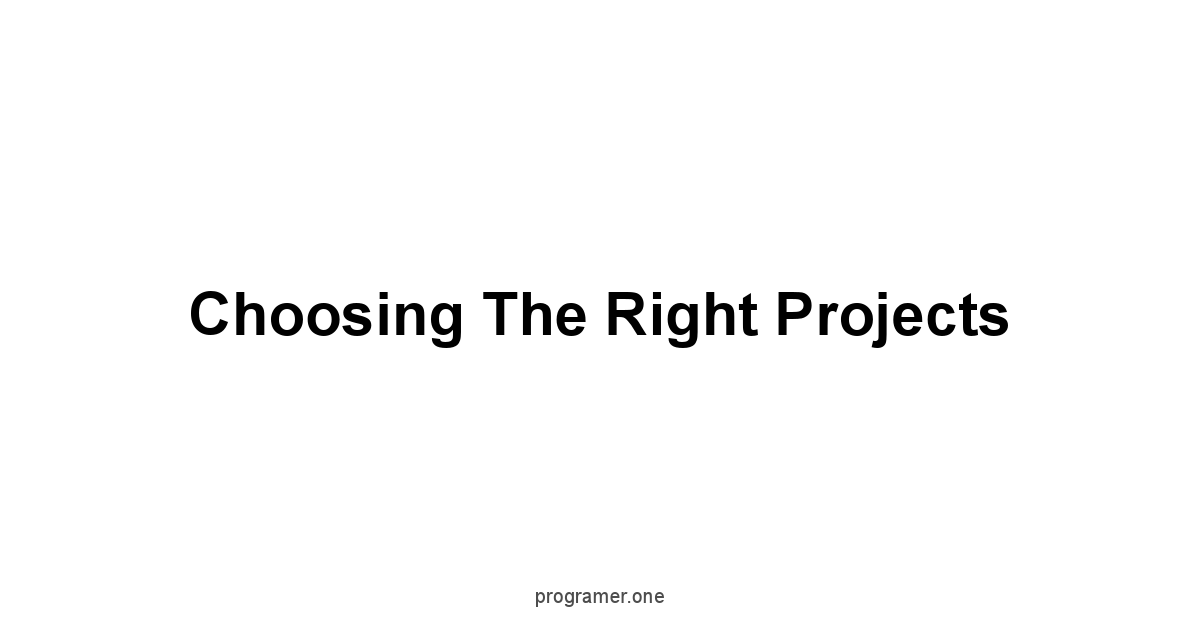
Choosing the right projects, it’s about strategy, not luck.
It is your opportunity to showcase your skills and passion.
The projects you select must reflect your career aspirations and technical strengths.
Think of each project as a piece of a puzzle, fitting together to form a complete picture of your capabilities.
It’s about demonstrating the breadth and depth of your skills.
A project, it’s more than just code.
It represents your ability to think critically, solve problems, and execute ideas. Projects show potential employers how you work.
They see the results of your effort and they understand your thought process.
Selecting the right ones can significantly increase the effectiveness of your portfolio, getting you the job you want.
Projects That Showcase Your Strengths
Projects, they should highlight your best abilities.
If you are a master of front-end development, you’ll show off a complex single-page application with great user experience.
If back-end development is your forte, you will build an API or a database that demonstrates your skills.
Don’t hide your skills, show them off, be proud of the work that you do.
The aim here is to make your strengths very evident.
Here’s how to pick projects that highlight your specific skills:
- Front-End Focus: Develop a rich, interactive web application using HTML, CSS, and JavaScript.
- Back-End Expertise: Build an API using a technology like Node.js or Python with databases.
- Mobile Development: Create a cross-platform app with React Native or Flutter.
- Data Science: Demonstrate your analytical skills with a project that uses machine learning or data analysis.
- Game Development: If you like building games, build a demo using Unity or Unreal Engine.
Make your skills stand out, use the projects to show them to potential employers.
Aligning Projects With Your Career Path
The projects you choose, they need to align with your career path.
If you dream of a job in fintech, you will need to show projects that feature financial applications or algorithms.
If you want to work in AI, you should show projects involving machine learning or data analysis.
This alignment shows employers that you’re serious and focused, you are not just throwing things at the wall, you are carefully making every move.
Think of this alignment as your story. The projects, they are your evidence.
Here is how you can align your projects to different career paths:
- Fintech: Develop a trading bot, a budgeting app, or a fraud detection system.
- AI and Machine Learning: Build a classifier, an object recognition system, or a sentiment analysis tool.
- E-commerce: Show off a full online store with a shopping cart and a payment system.
- Cybersecurity: Develop a penetration testing tool or a security auditing application.
- Web Development: Create a portfolio website, a social media platform, or a content management system.
Make sure that your projects fit the narrative that you want to tell.
Balancing Complexity and Completion
Balancing complexity with completion, it’s an art.
A complex project that remains unfinished does not do anyone any good.
A series of small, completed projects is better than one large, unfinished one.
A completed project, even if simple, shows you can deliver.
The trick here is to choose projects that challenge you but that you can also finish.
Here are some points to consider:
- Start Small: Start with simpler projects. As you complete them you can get more complex.
- Time Management: Learn to estimate how long a project will take you to complete and stick to those deadlines.
- Scope Creep: Avoid adding more features once you have started building the project.
- Milestones: Set clear milestones for progress and stick to them.
- Don’t Be Afraid to Scale Down: If you feel that you cannot finish a project, reduce the scope of the project.
Always finish what you start and remember that it’s always better to complete smaller projects than start something big that you will not finish.
Finding Project Ideas
Finding project ideas, it can be a challenge, but it’s also an opportunity.
Look at everyday problems or needs, what bothers you? Can it be improved or automated? The best projects often come from real problems, things that are close to your heart.
This ensures your passion shines through, making the project more compelling.
Here are some practical ways to find great project ideas:
- Personal Problems: Identify issues in your daily life that you can solve with code.
- Industry Trends: Follow current trends in tech, and see what gaps you can fill.
- Online Challenges: Participate in coding challenges that can provide inspiration.
- Open Source Projects: Contribute to open-source projects, they can provide lots of great ideas.
- Courses & Tutorials: Use what you learned in classes as a base for projects.
- Brainstorming: Always keep a notepad with you, and jot down your ideas.
- Community: Discuss project ideas with fellow developers, see what they are working on.
The goal is to find something that will engage you, this will make it easier to complete.
When to Abandon a Project
Knowing when to abandon a project, it’s as important as starting one.
If a project is going nowhere, if you cannot learn anything new, it is time to cut your losses.
Don’t waste time on a project that will not benefit you.
It’s a lesson in efficiency and focus, knowing that you do not need to finish everything you start.
Sometimes the most important decision you can make is to walk away.
Here are a few signs that it’s time to let a project go:
- Lack of Learning: If the project stops teaching you anything new, it may be time to move on.
- Stagnation: You have stalled, you have no momentum, and you do not feel like working on the project.
- Scope Creep: You cannot stop adding features and are getting completely off track.
- Overwhelming Challenges: If the project becomes too complex and you do not have the skill or time to finish.
- Loss of Interest: If the project no longer excites you, it’s time to focus your efforts elsewhere.
Recognizing when to stop is not failure, it’s a strategy for maximizing your time and efficiency.
Project Types That Impress
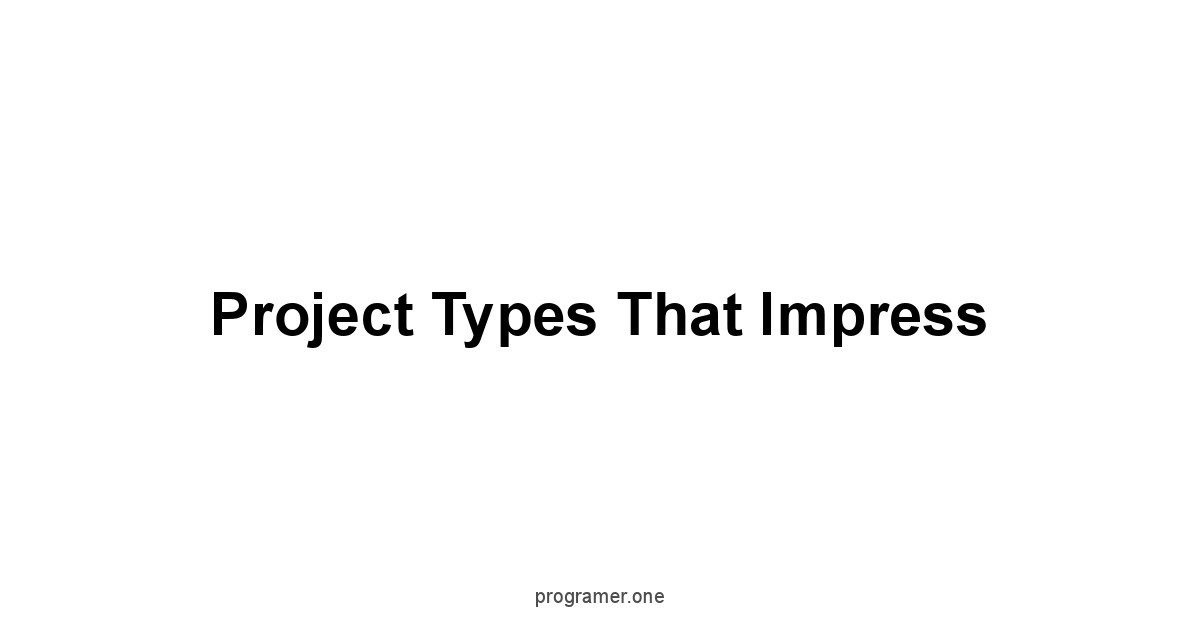
Project types, they are varied but some stand out more than others.
Some projects are more likely to get the attention of potential employers.
Showing a wide variety of projects demonstrates your versatility and deep knowledge.
This section will cover the different types of projects that stand out and that you should consider to include in your portfolio.
These are not just projects, they are proof of your ability.
They show that you are well-rounded and able to adapt to the demands of the tech industry.
Each project acts as evidence of your technical prowess.
Web Applications and Front-End Mastery
Web applications, they’re a staple in the tech world.
They demonstrate your ability to create interactive and user-friendly interfaces.
You need to build web apps that showcase a solid grasp of HTML, CSS, and JavaScript, along with modern frameworks like React, Angular, or Vue.
Building high-quality web apps is very important for your portfolio.
Here are some key aspects of a successful web application project:
- Responsive Design: Make sure that your application works well across different devices.
- Interactive Elements: Use animations and dynamic elements to make the app more engaging.
- Component-Based Architecture: Break down the app into reusable components.
- State Management: Effectively manage the application’s state.
- Performance Optimization: Optimize the application for speed and efficiency.
- Accessibility: Ensure that the application is accessible for all users.
These projects should demonstrate not just functionality, but also attention to the detail of good design.
Mobile App Development
Mobile app development, it’s a popular choice, it shows that you can build for the devices most people use everyday.
Whether it’s a native app for iOS or Android or a cross-platform app with React Native or Flutter, mobile apps display your ability to create solutions for small screens.
It’s a very good skill to show off on your portfolio.
Here are some guidelines to make your mobile app project shine:
- Platform Specific: If building a native app you must be aware of the design guidelines for each platform.
- User Experience: Focus on creating an intuitive experience with easy navigation.
- Offline Support: Implement offline capabilities to improve user experience.
- API Integration: Connect to external APIs for data and functionality.
- Performance: Make sure the app is fast and does not lag or freeze.
- Testing: Test your application on different devices to make sure it works on all of them.
A well-built mobile app in your portfolio is sure to catch the eyes of potential employers.
Backend Engineering and APIs
Backend engineering, it’s the invisible force that powers web and mobile apps.
Projects showcasing your back-end abilities, such as building RESTful APIs with Node.js, Python Django/Flask, or Java, show your mastery of server-side logic.
You must demonstrate that you can manage databases and handle large amounts of data.
It’s not something visual but it is very important.
Here is what a strong back-end project should include:
- API Design: Well-defined and documented RESTful APIs.
- Database Management: Efficient database design and data handling.
- Authentication and Authorization: Implementation of secure user authentication systems.
- Server-Side Logic: Complex business logic that solves real-world problems.
- Scalability: Design that allows the system to handle a growing number of users.
- Security: Security is important, make sure you are careful.
- Performance: Make sure your back end is fast, you don’t want to be the reason for a slow application.
A good back-end project can make your portfolio stand out and impress those who understand the complexity of server-side programming.
Machine Learning and Data Science
Machine learning and data science, they are rapidly growing.
A project in this domain demonstrates your ability to work with algorithms and data.
Whether it’s a classification model, a data analysis project, or a visualization, you should show off your skills with tools like Python, TensorFlow, or scikit-learn.
This is a field with enormous potential, a great area to work on.
Here are some ideas to consider when working on a data science project:
- Data Analysis: Projects that uncover insights using data analysis techniques.
- Machine Learning Models: Implementation of various models such as regression, classification, or clustering.
- Data Visualization: Effective visualization of data that communicates insights.
- Feature Engineering: Create, or choose, features to maximize efficiency.
- Model Evaluation: Use metrics to evaluate the performance of the model.
- Real Data Sets: Use datasets that are relevant to real-world scenarios.
Working on projects in this field shows employers that you have a valuable and sought-after skill set.
Open Source Contributions
Open source contributions, it’s more than just code.
It’s a demonstration of your ability to collaborate, follow coding standards, and contribute to larger projects.
Being an active contributor to open-source projects highlights your commitment to the tech community.
This can also provide the opportunity to learn from others and improve your code.
Here’s what makes open-source contributions powerful for a portfolio:
- Community Engagement: It shows that you are engaged with the coding community.
- Coding Standards: Demonstrates that you can write code that follows community standards.
- Collaborative Work: Highlights your ability to work as part of a team.
- Problem Solving: Your contributions should showcase your ability to solve real-world problems.
- Code Quality: It proves that you write code that is efficient and readable.
Contributions to open source shows a commitment to the craft that employers value.
Showcasing Your Projects Effectively
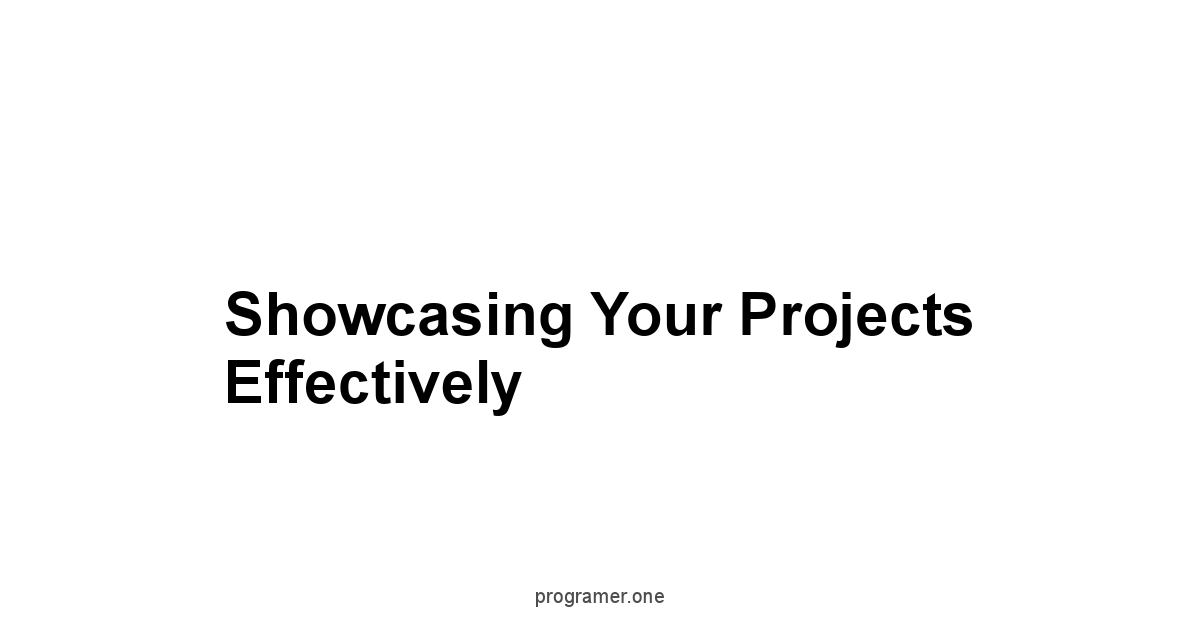
Showcasing your projects, it’s as important as the projects themselves.
It does not matter how complex the application, or how well it works.
If no one can see, or understand your project, then it has no purpose.
How you present your projects can mean the difference between getting an interview or being ignored.
Your portfolio is your opportunity to showcase your work. Make sure you do it well.
A well-presented project is a project that is easy to understand, easy to navigate, and easy to appreciate. Each project should tell a story.
It should also be easy for anyone to access the code and try it out if they want to.
Crafting Clear Project Descriptions
Clear project descriptions, they are crucial.
They should explain the project’s purpose, what problems it solves, and the technologies you used.
Your descriptions need to be concise, easy to understand, and highlight your skills.
This is not just about listing what you did, it’s about explaining why you did it and the challenges you overcame.
Make sure the language that you use is clear and not complicated.
Here is what makes a good project description:
- Project Goals: Explain why the project was created, what is it meant to do.
- Problem Statement: Clearly state the problem that you were trying to solve.
- Technologies Used: Mention every technology that you used, languages, frameworks, etc.
- Key Features: List the most important features of the project.
- Challenges and Solutions: Discuss any challenges that you encountered and how you overcame them.
- Lessons Learned: Mention what you learned from completing the project.
An effective project description guides the viewer through your project, helping them appreciate your skills.
Adding Compelling Visuals
Compelling visuals, they enhance your projects.
Screenshots, demos, and videos make your work come to life. A picture is worth a thousand words. Visuals are more engaging than just text. They also show your attention to detail and design.
It is important to show your work in the best way possible.
Visuals are key to making your projects more accessible.
Here are the types of visuals you should consider using:
- Screenshots: Include high-quality screenshots that display key features of the project.
- Demos: Record a short demo of the project running.
- Videos: Use videos to walk the user through the project and explain how to use it.
- UI/UX Design Mockups: Show design mockups, especially if you have a good sense for design.
- Graphics: Use custom graphics that showcase the best parts of the application.

Visuals will show that you are thoughtful about the whole experience.
Providing Access to Code Repositories
Access to code repositories, it’s important.
GitHub, GitLab, or Bitbucket provide a way for others to see your work, your coding style, and your organization of files.
It makes the work more accessible for anyone who wants to take a look at it.
This transparency is important, potential employers want to know that you are serious about your code.
Here are some important points when it comes to code repositories:
- Public Repositories: Make all your code public so anyone can see it.
- Well-Organized Code: Organize your files and folders in a clean and logical way.
- Clear Commit History: Commit small changes frequently with clear messages.
- Use Branches: Use branches to work on new features, and keep master/main clean.
- Code Style Consistency: Be consistent with the styling conventions for the language you use.
Providing easy access to your code adds credibility to your portfolio and shows that you are confident in your work.
Writing Readme Files That Explain It All
Readme files, they are the guide to your projects.
They should explain the purpose of the project, how to set it up, and how to run it.
A well-written readme makes it easy for anyone to use the project and helps the potential employer or anyone looking at your code to understand your way of thinking and the work that you have done.
Here is what a good readme file should include:
- Project Title: The full name of the project that you worked on.
- Description: A short description that summarizes the project.
- Setup Instructions: How to install all dependencies and how to set up the project.
- Usage Guide: How to run and use the project.
- API Documentation: If the project is an API make sure you explain all endpoints with details.
- Testing: If there are tests make sure that it is easy to run them.
- License: Add the license you used for the project.
- Contribution Guidelines: If you want other people to contribute to your project, add the guidelines.
A good readme makes your project user-friendly and makes a good first impression.
Choosing the Right Hosting Platform
Choosing the right hosting platform, it’s crucial for showcasing your web applications.
Platforms like Netlify, Vercel, or Heroku make it easy to deploy projects quickly and efficiently.
Choose the platform that aligns with your technical needs and budget.
This is your digital showcase, you want to choose a good location.
Here are some things to consider:
- Netlify: Good for static sites and front-end projects.
- Vercel: Great for modern front-end frameworks like React, Next.js.
- Heroku: Good for full-stack web applications and back-end projects.
- GitHub Pages: Simple hosting for static sites directly from your repository.
- AWS or Google Cloud: More advanced options for complex applications.
Choosing the right hosting platform makes your projects easy to access, adding a professional touch to your portfolio.
Maintaining and Updating Your Portfolio
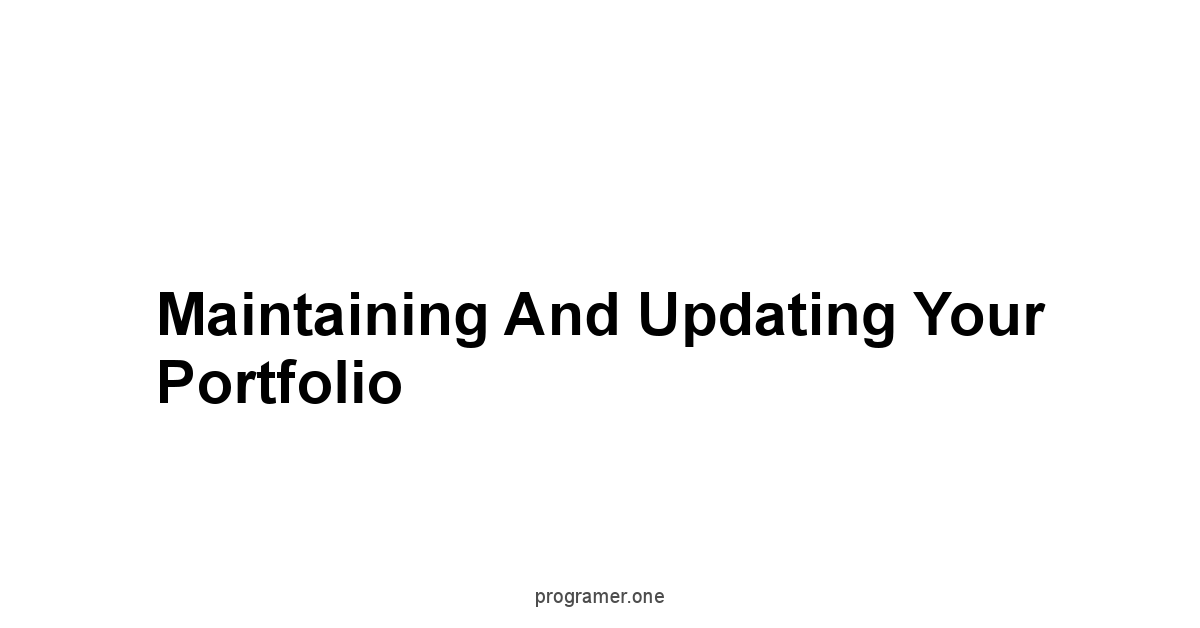
A stagnant portfolio, it’s like a museum piece, it does not reflect current trends or technologies. Keep it current, keep it fresh.
Regular updates show your commitment to learning and growth.
It shows employers that you are still active and are committed to the field.
Regularly Adding New Projects
Adding new projects, it shows progress.
It demonstrates you are continuously learning and growing.
Your portfolio should reflect that you are engaged with new technologies.
Every new project is an opportunity to showcase skills that you have learned.
Here’s why adding new projects is so important:
- Show Growth: Each new project shows your development as a programmer.
- Technical Agility: Demonstrates that you are able to adapt to new languages and technologies.
- Current Skills: Keeps your portfolio updated with the latest trends and practices.
- Passion: Show that you are passionate about coding and are working on it regularly.
A portfolio that grows over time is a portfolio that shows continuous improvement.
Revisiting and Improving Existing Work
Revisiting existing projects, it’s not just about adding new ones, but about refining the projects you already have.
As you grow as a developer, you will find ways to improve your old code and implement better solutions.
Use this opportunity to refactor your code, improve the design, or add new functionality.
Here is how to enhance your existing projects:
- Code Refactoring: Clean up and optimize old code, make it more efficient.
- User Experience Improvements: Improve the UI and overall user experience of your application.
- Add New Features: Introduce new functionality or expand on existing ones.
- Performance Enhancements: Find ways to improve speed and performance.
- Documentation Updates: Ensure the README files are up to date.
Improving existing work demonstrates your attention to detail and commitment to quality.
Getting Feedback and Iterating
Getting feedback, it’s essential. It provides a different perspective on your work.
Share your portfolio with peers, mentors, or potential employers. They might see flaws that you may have missed.
Be open to suggestions and use the feedback to improve your work.
Here’s how to effectively use feedback:
- Be Open: Be open to the suggestions that people provide you with.
- Actively Seek Feedback: Do not wait for it to come to you, seek it out.
- Consider All Comments: Evaluate every comment and see how it applies to your work.
- Iterate: Apply the feedback to refine your work and fix any mistakes you have made.
- Ask Questions: If a comment is unclear ask for details, make sure that you understand what was meant.
Feedback is a gift that will help you improve your projects.
Staying Up to Date With Industry Trends
Staying updated, it’s important to be aware of the ever-changing tech industry.
Follow the latest trends, new languages, new tools, and emerging technologies.
Keeping your portfolio aligned with these trends demonstrates your commitment to learning and professional growth.
It shows that you are aware of what is happening in the field.
Here are some ways to stay up to date:
- Read Blogs and Articles: Follow industry publications to stay informed.
- Attend Conferences: Participate in webinars and online events.
- Follow Tech Influencers: See what prominent figures are working on.
- Take Online Courses: Continue learning new technologies.
- Experiment: Explore new tools and technologies, build small projects with them.
- Join Communities: Participate in online communities to connect with others.
Staying current is essential to ensure your portfolio remains relevant.
The Importance of a Personal Website
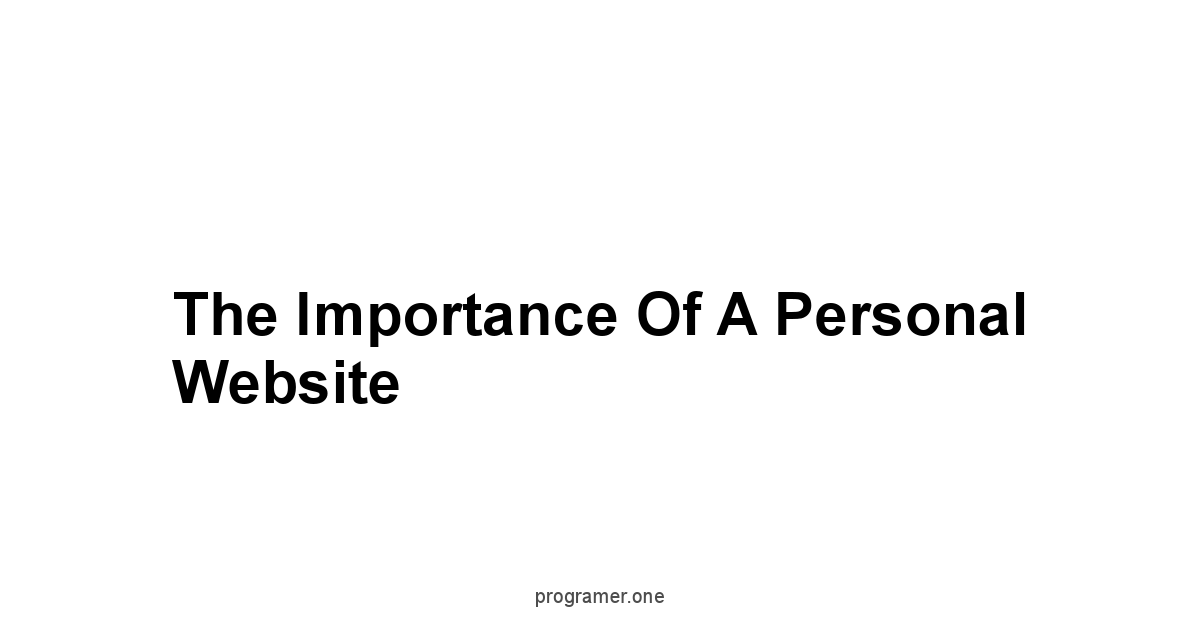
A personal website, it’s more than just a webpage, it’s your digital home.
It’s a place to showcase your portfolio and your brand.
It serves as a central location for potential employers, collaborators, and clients to learn more about your skills.
Think of it as a professional headquarters for your online presence, it is also a great place to express your creativity.
A personal website adds professionalism and personality to your portfolio, giving you more control over how you present yourself. It also allows you to express your personality.
Why a Custom Domain Matters
A custom domain, it elevates your brand, it shows that you are serious and professional.
A generic link on a platform like GitHub Pages or LinkedIn is not as memorable as a personal domain that says who you are.
It makes your website easier to find and looks more professional.
Here’s why a custom domain is essential:
- Professionalism: Shows that you are serious about your career and brand.
- Memorability: Makes it easier for people to find and remember your website.
- Brand Control: You have full control of your online presence, instead of being limited by other platforms.
- Credibility: Gives credibility and authority to your online presence.
- Search Engine Optimization SEO: Improves your search ranking and online visibility.
A custom domain is an investment in your personal brand that pays off in the long run.
Designing an Easy-to-Navigate Site
An easy-to-navigate site, it’s key to a positive user experience.
Visitors must be able to find what they need quickly and easily.
A clear layout and simple design help people appreciate your work without being distracted by the website.
A website that is easy to use and looks good will always leave a positive impact on whoever visits it.
Here are some principles of good website design:
- Simple Navigation: Easy menus and clear site structure make navigating a breeze.
- Responsive Design: Your website needs to be accessible on any device.
- Fast Loading Times: Optimize the speed of your website so that it loads fast.
- Consistent Design: Use consistent colors, fonts, and styles throughout the site.
- Clear Call to Action: Make it very clear how people can reach you or what actions you want them to take.
A user-friendly website is crucial for a good first impression.
Presenting Your Skills and Experience
Presenting skills and experience, it’s an opportunity to show your capabilities.
Your personal website is the perfect place to highlight your expertise.
List the technologies you’re proficient with, the projects you’ve completed, and any relevant work experience that you may have. It is important to clearly state your strengths.
Here’s how to showcase your skills effectively:
- Skills Section: Create a section listing all your technical skills.
- Project Showcases: Display your best projects with clear descriptions, images, and links.
- Experience Summary: Summarize your work history and relevant experience.
- Achievements: Showcase any awards, certifications, or notable achievements.
- Testimonials: If you have any testimonials, add them to your website.
A well-presented skills section ensures visitors know exactly what you bring to the table.
Including a Contact Form
A contact form, it’s an essential feature for your website.
It makes it easy for people to reach you, it ensures that communication can happen easily.
A contact form that is integrated into your site makes it simple for potential employers, clients, or collaborators to contact you.
Here are the key features of a good contact form:
- Clear Fields: Use labels for all fields.
- Email Notifications: Ensure that you receive an email each time the form is submitted.
- Thank You Message: Make sure that there is a message when the contact form is submitted.
- Spam Protection: Use methods to block spam.
- Security: Ensure that the form is secure.
A contact form can increase engagement on your website.
Adding a Blog to Demonstrate Your Knowledge
Adding a blog, it’s a great way to show what you know.
Writing blog posts about technology shows your passion for programming and allows you to share your knowledge with the world.
It also shows your ability to explain complex topics in a clear way.
A blog shows that you can explain and communicate well.
Here are the benefits of having a blog:
- Demonstrates Expertise: Shows your knowledge and understanding of various topics.
- Content Creation: Showcases your ability to create written content.
- SEO Improvement: It helps improve your site’s search engine optimization.
- Audience Engagement: It is a way to interact with your audience.
- Personal Growth: It forces you to learn more, and it also helps you refine your understanding of specific topics.
A blog adds depth to your portfolio, setting you apart from the competition.
Networking and Sharing Your Portfolio
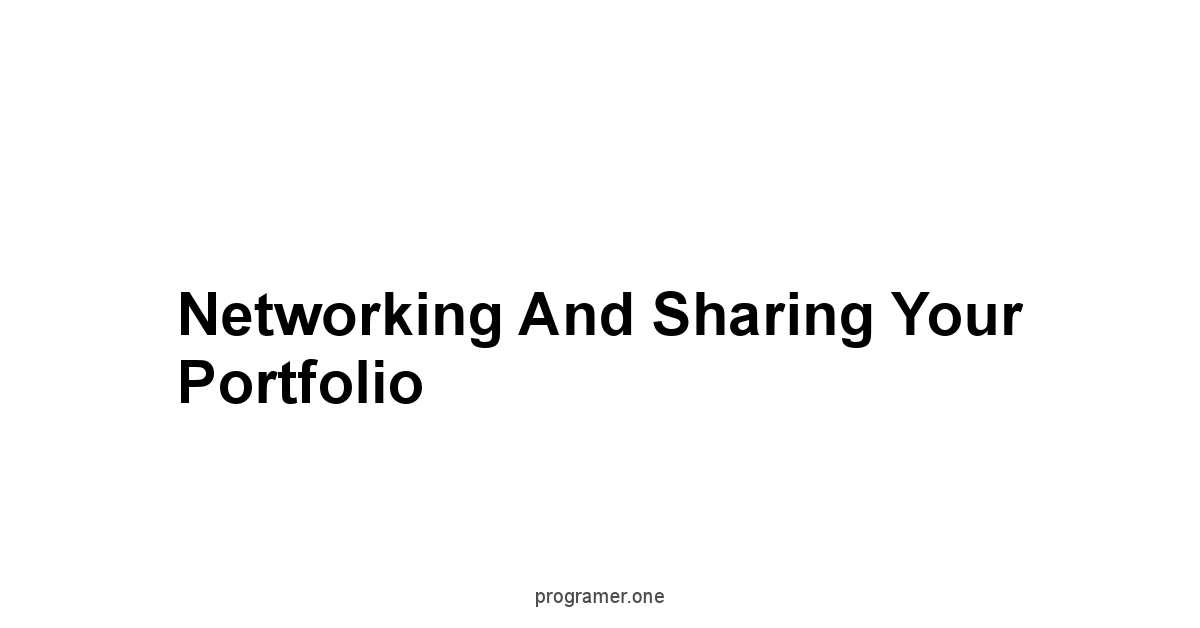
Networking and sharing your portfolio, it’s the final step in maximizing your visibility and opportunities.
A great portfolio does not matter if no one can see it.
Networking is a way to make sure that you will be seen.
Use online platforms and communities to build connections with potential employers, collaborators, and mentors.
Building a network and sharing your work is how you will expand your career opportunities and move forward. It’s an investment in your future.
Leveraging LinkedIn and GitHub
LinkedIn and GitHub, they’re essential tools for every programmer.
LinkedIn is for professional connections and job opportunities. GitHub is where your code lives.
Make sure that your profiles are complete, professional, and updated with your latest work.
These platforms should be a priority for your professional growth.
Here are some ways to get the most out of these two platforms:
- LinkedIn:
- Complete your profile with all your experiences, skills, and achievements.
- Connect with people in your field.
- Share updates about your projects.
- Engage with relevant content.
- GitHub:
- Keep your repositories updated with clean and organized code.
- Use a profile README to explain who you are and what you do.
- Contribute to other projects and participate in communities.
- Showcase your best work on your profile.
These two platforms are the key to being noticed. Make sure that you use them.
Participating in Online Communities
Online communities, they are where you can learn, connect, and collaborate.
Engage with communities such as Stack Overflow, Reddit, or Discord servers.
Share your work, answer questions, ask for advice, and contribute to discussions.
By participating in these communities you will become more involved and you will make new connections.
Here’s how to make the most of online communities:
- Engage in Discussions: Ask questions and participate in discussions.
- Offer Help: Share your knowledge and expertise.
- Showcase Your Projects: Share projects that you are proud of.
- Ask for Feedback: Get feedback on your work from peers.
- Contribute: Participate in community projects.
Community participation can expand your professional network.
Sharing Your Portfolio With Potential Employers
Sharing your portfolio, it’s crucial when applying for jobs or seeking freelance work.
Always make sure that you include your portfolio link in your resume, cover letter, and job applications.
Your portfolio is your greatest proof of your coding ability, it should not be hidden. It also serves as a visual aid during interviews.
Here’s what you should always do:
- Portfolio Link: Add a link to your portfolio on your resume.
- Cover Letters: Make sure that you mention your portfolio in your cover letter.
- Job Applications: Include the portfolio on job applications.
- Interviews: Use your portfolio to highlight your skills during the interviews.
Sharing your portfolio directly is essential to getting the attention of potential employers.
Seeking Mentorship and Feedback
Seeking mentorship, it’s vital for your growth. A mentor can provide advice, guidance, and support. They can also provide feedback on your portfolio. Mentors have often been in your position before.
Their experience can help you navigate many challenges you might face in your career.
Here’s how to seek mentorship and feedback:
- Connect with Experienced Developers: Find mentors with experience in the fields that you are interested in.
- Be Open to Feedback: Be willing to accept feedback that will improve your work.
- Regular Check-Ins: Connect with your mentors frequently.
- Ask Questions: Ask questions and get advice on your career path.
- Be Respectful: Always respect the time of your mentors.
Mentorship can be crucial to helping you with your portfolio and career.
Conclusion
In the end, a strong programming portfolio isn’t about having the most projects, or the most complex code.
It’s about clarity, about telling your story as a developer.
It’s about showing the problems you can solve and the value you bring.
It’s a reflection of your skills, your passion, and your dedication to the craft.
A portfolio that is carefully put together with well-chosen projects, clear descriptions, and a personal touch, it’s a powerful tool that can open many doors.
The key to building this, it’s a continuous process, not a one-time task.
Keep learning, keep building, and keep refining your work.
By regularly adding new projects, revisiting old code, and staying up to date with industry trends, you ensure your portfolio remains relevant.
Data from sources like the Bureau of Labor Statistics project a 22% growth in software development jobs over the next decade, making it clear that the demand for skilled developers is not going away, and a strong portfolio is crucial to stand out in this competitive field.
Remember also, that your portfolio is also an extension of you, so it should reflect your unique brand and personality.
It must be more than just a collection of code, it should reflect your approach to problems.
Having a well-designed personal website with a custom domain, easy navigation, and clear contact information makes it easier for potential employers to get in touch with you.
A blog where you share what you know, can show off not only your technical abilities, but also your communication skills, which are so important when working on any team.
Ultimately, the goal here is not just to have a great portfolio, but to use it effectively.
By sharing your work, actively networking, and seeking mentorship you can maximize your opportunities.
Connect with others, participate in online communities, and always include a link to your portfolio when applying for work.
A good portfolio is not just a collection of projects, it is a tool that is continuously sharpened and always ready to be used to get to the next level of your career.
Frequently Asked Questions
What exactly is a strong programming portfolio?
It’s not just a pile of code.
It’s a collection of your best work that tells a story about your skills.
It shows what you can do, how you solve problems, and how you approach the work.
It is your digital handshake, your first impression, so make it count.
Why is a strong portfolio so important?
A weak portfolio, it’s a missed chance. A strong one, it opens doors.
It shows that you can build, not just talk about it.
It can make the difference between getting an interview and getting passed over. You need it to be clear, effective, and memorable.
What makes a portfolio stand out?
It’s not about having the most projects, but the best ones. Focus on quality over quantity.
Show the depth of your skills, and tell a story with each project.
It’s about problem-solving, clear objectives, good code, and some unique ideas.
How do I figure out who my portfolio is for?
You need to know your audience, before you start building.
Are you targeting startups, big companies, or freelance work? Each one wants something different. Tailor your portfolio to fit the job you want.
How do I set goals for my portfolio?
Define what you want to achieve.
Are you looking for a job, freelance work, or collaborations? Maybe you want to show mastery in a certain tech.
Clear goals keep your efforts focused and effective. Don’t get scattered.
How do I pick the right projects?
Pick projects that show off your skills and what you want to do.
Each project is part of a puzzle that will show what you are able to do. Show your strengths, don’t hide them.
It’s not just code, it’s your ability to think and execute ideas.
What if a project is too hard or not going well?
Knowing when to stop, it’s as important as starting. Don’t waste time on something that’s not working.
If you are not learning, or you lost interest, it’s time to move on. It’s not a failure, it’s about efficiency.
What kind of projects impress employers?
Some projects stand out more than others.
Web applications, mobile apps, back-end work, machine learning, and open-source contributions, all of these will show your versatility and knowledge.
Choose the ones that best represent your strengths.
How do I show off my projects effectively?
It’s not enough to build, you need to present well.
Use clear descriptions, visuals, code repositories, and README files.
Make sure your projects are easy to understand and navigate.
Make sure that it’s easy to see the great work you have done.
Why should I care about a personal website?
It’s your digital home, your online headquarters.
It’s where you showcase your portfolio and your brand.
A good website gives you control over your online presence and makes you look professional.
It’s also a great place to express your personality.
Why should I bother with a blog?
A blog shows that you know what you are doing.
It also shows your passion for programming and your ability to explain complex ideas.
This sets you apart and adds depth to your portfolio.
How do I network with my portfolio?
Use LinkedIn and GitHub, participate in online communities, and share your portfolio with potential employers. Networking is essential.
Build connections with people that may help you in your career.
What’s the deal with mentors?
Mentors can provide advice and support, and they can also give you feedback on your portfolio.
Their experience can help you navigate the challenges in your career.
How often should I update my portfolio?
The tech world is always changing. Your portfolio should change with it.
Add new projects, revisit your old ones, and make sure that you are staying up to date with the trends. Keep your portfolio fresh and current.




